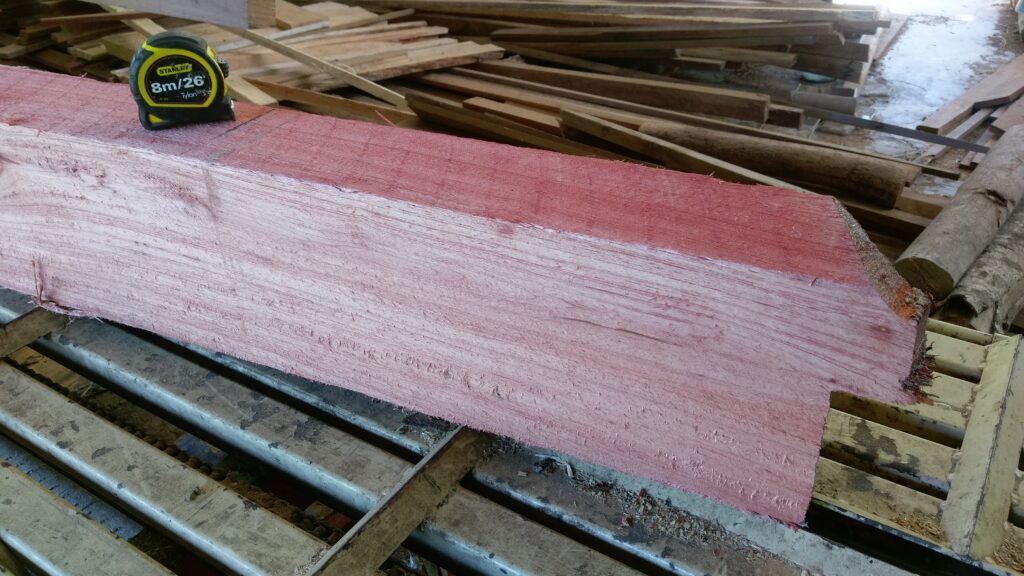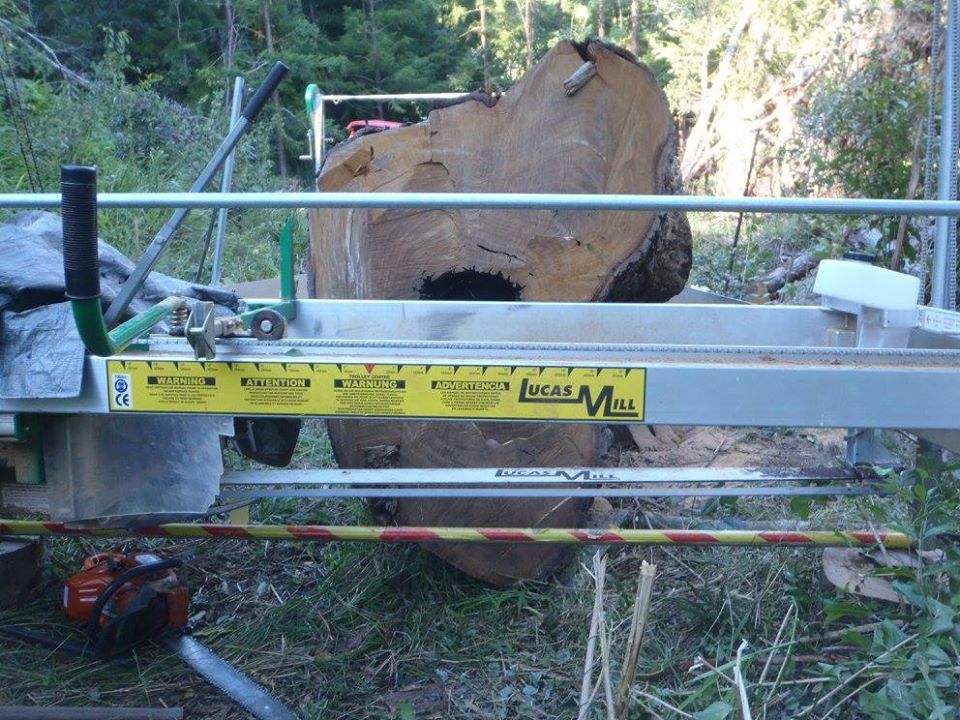Chapter 8
Sawmills
I now own two sawmills. A large expensive one for cutting small logs and a smaller and cheaper one for cutting large logs. The first one has come all the way from Finland and the other is an Aussie. Cutting this massive log with my son in law’s help,some large 5 ft wide slabs with the small sawmill, which cuts large logs. The GM log was so big we had to take the mill to the log. The slabs have made some wonderful furniture.

Firewood
Please enjoy this firewood. To increase your fiery pleasure may we point out a few interesting facts about the wood: All of the wood has come from Bob’s Farm, from trees he has mostly planted himself from the ’70’s. The species that you are burning are:
1: The ‘World Famous’ Gympie Messmate. Famed for being fast growing, highest levels of durability, plantation tolerant species. Grown around the world. All the new hardwood timber used in this house is from Gympie Messmate. The heaviest wood in the stack and tan to grey in colour. The flooring in front of the photo is also from my GM trees and sawmill.
2: Flooded Gum (grows where rivers flood). This is a pink coloured light wood. Recorded in the 1967 Guinness Book of Records as the fastest growing (flowering) tree…. in Uganda.
3: Grey Gum (bark is grey, with the new bark a bright orange, timber is red but faulty). The Koalas favourite food tree!
4: Queensland Maple (timber a pale variegated pink in colour, named after the classic maple leaf of the tree’s foliage). According to Morris Lake, author of the definitive ‘Rainforest Woods of Australia’, Australia’s most valuable furniture timber! Also the timber used in World War One and Two aircraft propellers, due to its fabulous strength to weight ratio!
5: Red Cedar (in fact a Mahogany, the timber obvious for its deep rich red colour). Australia’s ‘Tree of History’. For it’s outstanding colour, Governor Phillip included Red Cedar in his first shipment of Australiana back to England. The first European Settlers into many districts of Queensland came to harvest Red Cedar trees. All the wood here comes from (The) ‘Cedar Pocket’, a small community south-east of Gympie. Bob has even seen Red Cedar being sold for $12,000 per cubic metre! What a decadence to burn, you may feel like a roman emperor, basking in the warmth of Red Cedar logs!
6: White Cedar (the timber is similar to the above but perhaps more figured and a plainer yellower colour).
7: Silver Ash (very pale timber with a slight yellowy tinge). This wood is excellent for bending and is used therefore in the repair of wooden wheels. It is used in all aspects of the wheel, the ‘half rim’, spokes and hub. It has such spring it can also be used for Long Bows! But also prized as a furniture timber.
8: Camphor Laurel (variegated timber of yellow-to-umber-to-black colour, with the distinctive camphor aroma, tending to an incense smell when burnt). Unfortunately considered a weed invasive from China, were it is known as ‘Jung Sui’ or ‘Kusunoki’. The ‘Welcome Post’ by the front door is Camphor Laurel, as it is a good carving timber (the post is black due to an erroneous application of Organ Oil!) Also very popular for cutting boards etc, as it is popularly believed the aroma kills germs!
9: Hoop Pine (a pale creamy white timber with regular knots, the only softwood in the stack, and used for the weatherboarding here). Excellent wood for starting the fire as it burns readily and fast. A Subtropical ‘Pine’ so no pronounced growth rings, making the timber even and consistent, prized for furniture making and house building.
10: Axe Handle Wood (Athene phillipeniensis. A pale off-white timber). This fabled timber has a reputation from the pioneer days for being used in axe handles due to its excellent vibration-absorption qualities and fine grained easy-to-work timber.
11: Lignum Vitae, which means, Tree of Life. A hard slow growing rainforest tree.
12: Bunya Pine. The wood is very similar to Hoop Pine but it has large life threatening edible large nuts. My totem, I say this with some good reason.
Transcendence, Here, Now and Around us
I was visited by about a dozen architecture students yesterday. It turned out that most of them were Asians. They were interested in my timber, specifically Gympie Messmate and the sawmill. They don’t have wood as hard and as heavy as my GM.I said I would show them how it operated. Usually I do this with an assistant who operates the tractor while I operate the mill but today, I had to do it all myself. To do it, I have to start the tractor, engage the mill and the saw, climb down from the tractor, climb over the sawmill’s sliding table, operate the mill and single handedly saw the wood into dimensions, when that it done, I climb over the mill again, mount the tractor and turn everything off. Once I had done it all, they broke into spontaneous applause. I was a bit shocked as it is relatively normal for me but they must have been impressed with the whole show, the wood,the sawmill, and even the shed I built myself with my wood. I donated a few pieces of wood to them and they left happily.
I stayed in the mill and did a bit of tidying up and was barely listening to the radio where there was some pretentious gratuitous crap being broadcast as usual. Next came on this unannounced piece which I could only just hear. I thought, what is that, and moved closer to the radio and turned it up a little so I could hear it better!? It was extraordinary. I had never heard it before and was taken in. It only lasted a short time and then the announcer said it was a Busoni piano arrangement of Bach’s “Rejoice Good Christians”. Permit me to say in the shock of the moment my thought, it was that transcendence is here now and all around us. How any human could write music like that, I do not know. It is unfathomable. Yes,it can be found on the internet.

